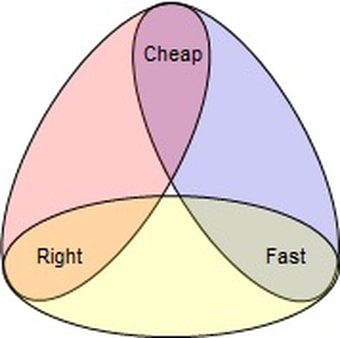
So often the big questions in an initial inquiry are as follows, and in this order;
1. Can you do it?
2. How much will it cost?
3. How fast can you do it?
In this blog, we'll cover these questions and what needs to be considered in each.
- Can you do it? = Can you complete the project bestowed upon you to our standards? = "RIGHT"
- How much will it cost? = Can you complete the project bestowed upon you within our budget? = "CHEAP"
- How fast can you do it? = Can you complete the project bestowed upon you within our timeline? = "FAST"
If anyone says yes to all three of these points, they're lying to you. When developing a product, any product, be it new or simply an iteration of an existing product, you have three governing concepts to consider. CHEAP, FAST and RIGHT. You can ONLY pick two of these; PERIOD!!!
A deeper dive...
Can you do it?
The implicit question that's actually being asked is, "how well can you do it?". This separates all design firms and is a function not only of skill set but resources available. Time is one of those resources as we'll see when we review, "How fast can you do it?". But remember, time is money.
I's ALWAYS important to ask and confirm the skills and resources (time included) of the design firm(s) and of the team(s) that will be allocated to your project?
How much will it cost?
Obviously rates will vary depending on the pay rate of the designer(s) and engineer(s) on your respective project as well as the resources that need to be applied. If you request the project be expedited, more people need to be allocated to the project which means the cost increases. If you want to improve the quality of the project, the quality of the team increases accordingly and so do the rates.
How fast can you do it?
Again, this depends on complexity and manpower but also how much you're willing to spend. Everyone has a budget. No matter how big or small your company or project, a budget has been allocated based on the expected return on the investment. For the purposes of this blog post, return on investment is the end goal. However, not the "key" to success. We'll cover this elusive "key" in other blog posts. For now, whether the marketing strategy appears altruistic or not, the reason you're creating a product is to solve a problem. BUT, you need to make a profit while doing it.
So which two would you pick most of the time?
 RSS Feed
RSS Feed